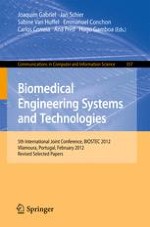2013 | Book
Biomedical Engineering Systems and Technologies
5th International Joint Conference, BIOSTEC 2012, Vilamoura, Portugal, February 1-4, 2012, Revised Selected Papers
Editors: Joaquim Gabriel, Jan Schier, Sabine Van Huffel, Emmanuel Conchon, Carlos Correia, Ana Fred, Hugo Gamboa
Publisher: Springer Berlin Heidelberg
Book Series : Communications in Computer and Information Science
